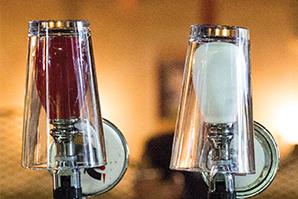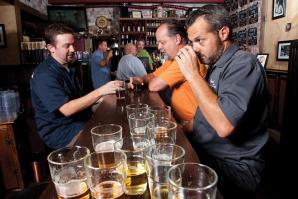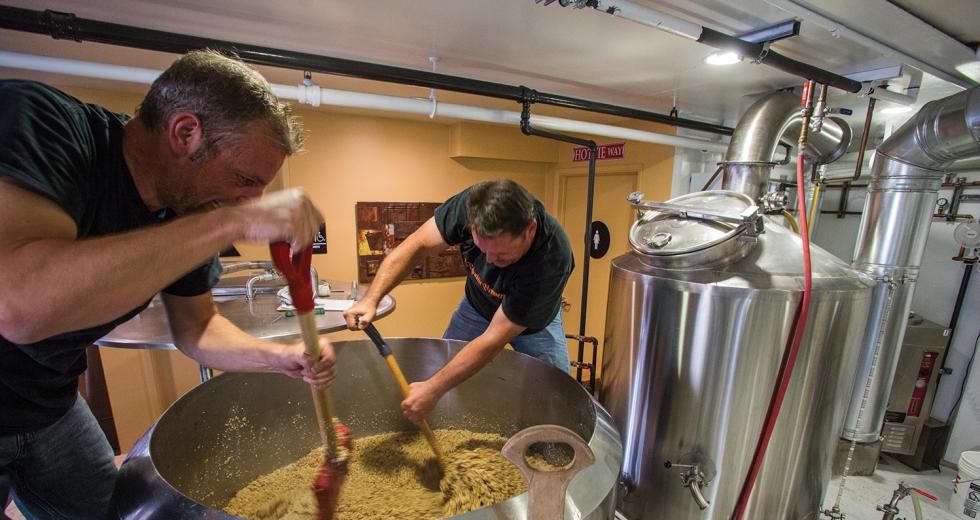Early business success often brings challenges. In the case of ol’ Republic Brewery, the biggest challenge is meeting consumer demand.
“Quite frankly, we’re in a quandary,” says Jim Harte, founding partner and brewer at the Nevada City-based craft brewery and tap room. When he and partner Simon Olney opened the business in February below the longstanding SPD Market grocery store, the initial pouring of European-style lagers and ales was met with much acclaim by industry experts and, more importantly, by craft beer drinkers.
Like many startup craft breweries across North America, the foundation of ol’ Republic’s business model was based on an entry-level, seven-barrel system — a sound business decision, according to Tom Dalldorf, publisher and editor of Celebrator Beer News. He says most brewery startups correctly project up to two years are needed for demand to catch up with production capacity. For ol’ Republic, it took just seven months.
Harte summarizes the conundrum this way: It takes six to eight weeks for he and Olney to produce, ferment and age a barrel of lager. For ales, it takes about half that time. However, it takes less than three weeks to sell through a barrel. The twosome brews about eight batches a month while holding down the fort on all other business fronts. Their production equipment — four fermentation tanks and eight aging tanks — are at capacity, so they can’t just produce more beer.
“Given our current business plan, equipment, space, storage capacity and general overhead, we are maxed out,” Harte says. “In some ways, it’s a good problem to have, but we sure weren’t prepared to start thinking about chapter two of our business at this stage. We’re too busy handling the day-to-day operation to spend much time on the big picture.”
Harte self-funded the startup with money earned through two decades in the Northern California wine business, working primarily in marketing and business finance positions. Thanks to a couple of lucrative buyouts, he had the money to pursue full time what had been a lifelong hobby — home brewing. And he was pretty good at it, winning numerous awards, including gold and bronze medals at the California State Fair.
One afternoon over a couple bottles of sake, Harte and Olney hatched the plan that would become ol’ Republic. It would be based in Harte’s hometown of Nevada City and attach itself to the colorful Gold Rush history of the area. Olney’s background in design, English heritage and love for a good lager balanced Harte’s business acumen and financial wherewithal.
There are plenty of expansion options the duo can pursue: Buy more tanks, buy a bigger production system, hire another brewmaster and staff. But these steps are costly. Increased production also would create need for additional delivery points, such as restaurants, markets and maybe future ol’ Republics. It’s something Harte would like to pursue someday, but less than a year into the business, he’s left scratching his head.
“I take pride in the fact that we are 100 percent self-funded. We have been operating in the black since the day we opened,” Harte says. “Granted, Simon and I are barely making enough money to keep us in cigarettes and beer. But since we each work six double shifts a week, we don’t have much time to spend money on anything else.”
Harte admits it will be extraordinarily difficult to go to his most important partner — his wife Laura — and tell her it’s time to re-up. “You can’t print in a family magazine what her response would be to me,” he says. Also, Harte is leery of how receptive the small-business loan community will be to an operation like his, with such a short track record.
“What if nobody walks in the door tomorrow? At night, in bed, I think about that often.”
— Jim Harte, founding partner and brewer, ol’ Republic Brewery
Editor Dalldorf says the overall success of the craft brew industry should favor ol’ Republic’s loan pursuit. He cites Brewer Association statistics that show double-digit growth in craft beer sales in every year for the past 10. He also notes that eight craft brewers operated in the U.S. in 1980; today, there are nearly 2,000.
“We wouldn’t be seeing this kind of growth if consumers weren’t
buying and drinking craft brews,” Dalldorf says. But despite
these industry numbers, as well as ol’ Republic’s overwhelming
early success, he agrees the twosome likely will be in for a
rough time on the borrowing front.
Two regional bankers do not necessarily agree.
John DiMichele is CEO of West Sacramento-based Community Bank. In addition to being a craft brew drinker, he also has a brother who was once a master brewer and helped launch River City Brewing Co.
“The ol’ Republic business model is a sound model. It has a proven track record in a growing industry,” DiMichele says. “While it has a relatively short record of success, it does have a record. In the line for an SBA loan, it would put them ahead of other startups in the food and drink industry.”
He says their biggest challenge will be putting the required financial statements together. However, since the business was self-funded, the current equipment could be subordinate to the loan. DiMichele says that asset, and the fact the partners are putting in most of the successful effort on their own, will make them more attractive to bankers.
Mike Rizzo, senior vice president for Five Star Bank, also says the Nevada City craft brewers have something of value to bring to the lending table.
“Although there will be plenty of hoops for them to jump through, it sounds like a quality candidate for an SBA 7(a) loan,” Rizzo says. “They’ve had a successful startup phase, and a partner with apparently a good business and financial background. Bankers like that.”
However, he says the relative newness of the business will present some problems. Since the bank can’t ask for three years of business records, personal financial records and tax returns of major stakeholders would be required.
“In any closely held business, it’s all about the major shareholders’ finances,” Rizzo says. “There needs to be a balance between having a super strong business and a weak guarantor or vice versa. On the face of it, they seem to be looking good at both ends.”
Dalldorf, who has been covering the nation’s craft brew business for more than 24 years, says ol’ Republic can pursue cheaper options.
“There are some fancy ways to share operations for a time,” Dalldorf says. “Harte could go down to [another brewery] and work out an arrangement to brew his beer there when production capacity was available. He would have to work out the logistics and storage and shipping, but it could be done for much less cost than buying a new production system.”
Dalldorf cited operations known as “gypsy brewers” that have no home base for brewing but are plugged into the regional industry. He says every month they might go to a different operation that has excess production capacity. It could be tough logistically, but many craft brewers have made it work.
And finally, there’s contract brewing. Many large, nationally distributed brewers take this route, providing recipes to a large production facility that makes the beer and ships it back. This is one option Harte and Olney have no interest in considering.
“Besides the wonderful and creative recipes Jim has created, what makes our beer so special is its consistency,” Olney says. “We can guarantee that consistency because we do it every time.”
Harte says he is pleased with the early success of his lifelong dream, but he is hesitant to rush to the next phase.
“We always thought it would become something much bigger than what we currently have. Our goal was never to simply create jobs for the two of us,” he says.
“We just thought it would take two years. We’re fortunate so many people love our beer today, but the mob can be fickle. What if nobody walks in the door tomorrow? At night, in bed, I think about that often.”
BOTTOMS UP
Notes from the tasting flight at ol’
Republic
Committing to a reputation for memorable lagers was a very expensive decision. That style of beer takes a long time to brew, but the two partners at ‘ol Republic Brewery in Nevada City feel poised for the test.
“It’s the style of beer we both prefer, and we take pride in taking on the challenge to introduce these handcrafted lagers to everyone that walks through our doors,” says Jim Harte, a 28-year home brewing veteran and founding partner and brewer at the tap room.
It’s not that ol’ Republic is exclusively a lager house. Harte and partner Simon Olney also brew an assortment of English, black and red ales.
“Traditionally, it takes two to three weeks to make and age a classic ale, and with lagers, it’s six to eight weeks,” Olney says. “We actually end up aging most of our beers a lot like a lager; we even hang on to the English IPA for quite a while. We let it mold. When it’s ready, we’ll bring it out.”
The brewery opened in February, and Harte likes to believe a commitment to time and quality has helped ol’ Republic gain its large early following.
“We think of drinking a beer as an experience. People don’t come in here to slam pints in order to get a heater going. They’re actually here to enjoy a complex beer that changes profile while in the glass,” Harte says.
Ol’ Republic has seven beers on tap daily, and they change frequently based on production capacity and seasonal selections. Beers are available in Imperial pints and in take-home, stainless steel canisters called growlers.
— Douglas Curley
Editor’s Pick
Export Stout
This obsidian-colored English black stout offers the best of all
worlds. It has a creamy coffee flavor melted together with some
port-like qualities. It looks like a one-pint espresso shot. It’s
strong, weighty and rich, but perfectly balanced. “Half the
people that drink this say its heaven in a glass. The flavors
coat your entire mouth.”
Bavarian Black Lager
“This is the No. 1 beer we use to turn wine drinkers into beer
lovers,” Harte says. “We tell them it’s like Champagne made with
square grapes.” Deep mahogany in color, this beer has a subtle
coffee aroma with a restrained hop bitterness and flavor. It
offers a clean, fresh finish and will change your perspective on
lagers.
Celtic Red
One of Harte’s California State Fair medal winners, this
beautiful, deep-ruby-red ale is robust, complex and full-bodied
with a gentle touch of noble hops. “This beer has evolved into a
cross between Scotch ale and an Irish red, hence the Celtic name.
It’s another gateway beer for people not used to an ale so packed
with intense flavor.”
India Pale Ale
This style of ale was first brewed in the 1790s for export to
British colonies in India, and the ol’ Republic version of this
classic has its roots firmly planted in its original format with
loads of English hops. With a hefty, malty backbone, it packs a
punch of hop aroma and bitterness. “We had to do an IPA, but we
wanted it to be different. So we went with a more English style
with a little California attitude.”
Dead Canary
This lager recipe evolved during the mid-19th century in
Dortmund, Germany. ol’ Republic’s version is straw-colored, light
and crisp with a medium-dry finish perfect for newcomers to craft
beer and appreciated by connoisseurs. “It’s kind of like a
domestic light beer but with much less carbonation. It has tiny
Champagne bubbles instead of big soda pop bubbles.”
The beers reviewed above are not always available on the ol’
Republic tasting flight.
For more information on Ken James: www.kjamesimages.com
Recommended For You

Tapped Out
Is Sac's craft beer bubble on the verge of bursting?
When downtown Sacramento’s Brew It Up poured its last beer in 2011, owner Michael Costello lost more than his business. “I lost everything,” he says. “Nobody really knows the whole breadth of it. It’s not an easy thing to go through.”

Return to Hops
Craft beers gain momentum in the Capital Region
“I arrived in the City of Saloons,” wrote Mark Twain upon arriving here in 1866. “You can shut your eyes and march into the first door you come to and call for a drink, and the chances are that you will get it.”



